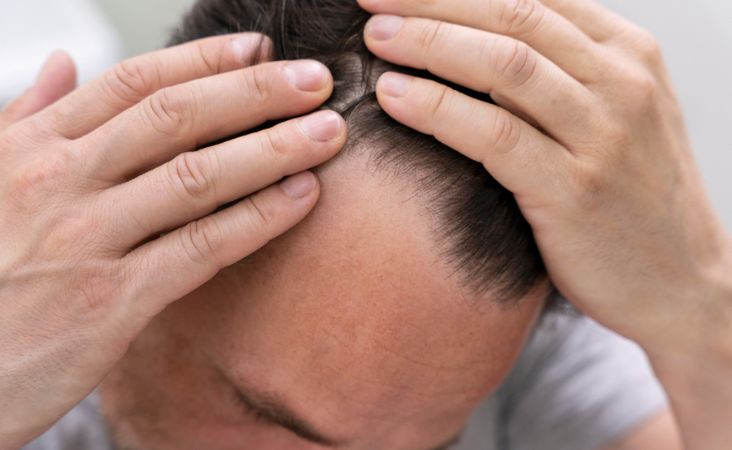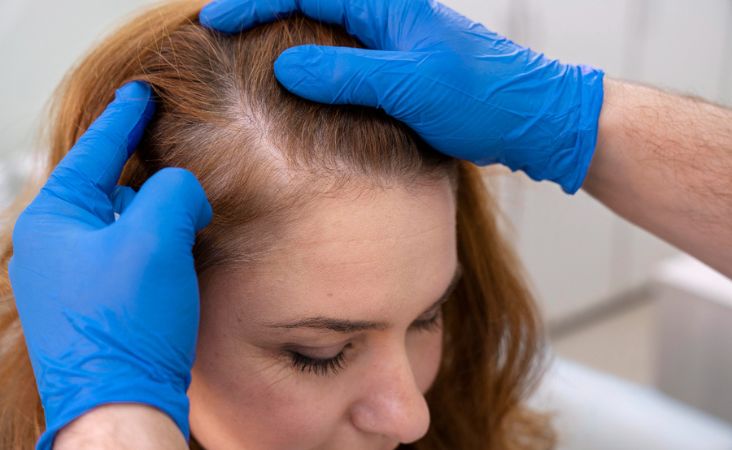Light Thinning vs. Progressed Thinning Hair: Differences for Fast Recovery
- by Vivek Khullar
- Apr 6, 2024
- |
- 8 min read
Thinning hair can shake your confidence, leaving you searching for solutions. But here's the catch: thinning is not of one kind. Many people mistakenly treat light thinning and progressed thinning the same way. This often leads to frustration and unmet expectations.
Lordhair - a global supplier of men’s hairpieces and women's wigs - is here to clear the air. In this blog, we'll delve into the key differences between these two hair loss concerns. We will help you understand each thinning situation and discover the right approach to get your mane back on track.
So, buckle up and get ready to learn! We bet that by the end, you'll be equipped to navigate the world of hair thinning with confidence.
Light Thinning vs. Progressed Thinning: Severity
Light thinning denotes a milder form of hair loss. It can be characterized by minimal impact on overall hair density. While some thinning may be noticeable, it typically doesn’t lead to significant bald patches or visibly sparse areas on the scalp. Progressed thinning, on the other hand, indicates a more severe condition where extensive hair loss occurs resulting in visible bald patches or significant reduction in hair density across multiple areas of the scalp.
The severity of progressed thinning indicates more aggressive interventions to address the substantial loss of hair volume and coverage.

Light Thinning vs. Progressed Thinning: Rate of Hair Loss
The rate of hair loss in light thinning tends to be gradual, with minor changes occurring over an extended period. Individuals experiencing this thinning condition may notice a slow but steady decrease in hair density, often spanning several months or even years.
Talking about progressed thinning, well, it involves a much faster rate of hair loss with noticeable changes occurring relatively quickly. Hair fall in this stage may accelerate rapidly. Meaning, this will lead to a more dramatic transformation in hair density and appearance within a shorter time frame compared to light thinning.
Light vs. Progressed Thinning: Scalp Visibility
Although there may be slight thinning of the strands in cases of first hair condition, visibility of the scalp is usually minimal. This means under normal lighting conditions and without close inspection, the scalp remains mostly concealed by the existing hair.
However, the scalp becomes increasingly visible in the progressed thinning as hair loss advances. This visibility often extends beyond specific areas of baldness to include larger portions of the scalp. Thus, making it more apparent even from a distance and under various lighting conditions.
Light vs. Progressed Thinning: Treatment Options
Regarding treatment options, light thinning is known to respond well to conservative treatment measures such as topical solutions, dietary adjustments, and lifestyle changes. These interventions aim to slow down the progression of hair loss and may include the use of over-the-counter products like minoxidil and dietary supplements promoting hair health.
Conversely, progressed thinning often requires more aggressive treatment approaches due to the advanced stage of hair loss. Yes, it’s true! Treatment options may include prescription medications like finasteride, surgical procedures such as hair transplantation, and advanced therapies like platelet-rich plasma (PRP) injections, tailored to address the severity of hair loss and promote regrowth.
Here’s the thing though.
There's no guarantee that these treatments will work for everyone, no matter light thinning or progressed thinning. However, there is one non-surgical solution that can help you regain hair confidence almost instantly. We'll discuss it at the end! Stay tuned!
Don’t forget to check out these resources:
Connection between hairstyles and hair loss explained
How to hydrate hair for optimum scalp and hair health
Basic hair care system for 2024
Your complete hair loss prevention guide!
Does the keto diet cause hair loss and damage?
10 vitamins and nutrients for hair growth
Light Thinning vs Progressive Thinning: Psychological Impact
Another important aspect to consider when talking about light thinning and progressive thinning. The former tends to have a milder psychological impact compared to the latter. While individuals experiencing light thinning may feel some level of concern or self-consciousness about their changing appearance, it typically does not significantly affect their overall self-esteem or mental well-being.
Progressed thinning, in contrast, can have a profound psychological impact. It can lead to feelings of embarrassment, anxiety, and stress. According to dermatologists and psychologists, noticeable changes in an individual’s appearance coupled with societal perceptions of beauty and ageing can significantly impact self-confidence and quality of life for those experiencing advanced hair loss.
Light Thinning vs Progressive Thinning: Genetic Factors
Light thinning may have genetic components, yes. But it often involves a combination of genetic predisposition and other contributing factors such as hormonal changes, stress, and lifestyle habits. Individuals with a family history of hair loss may be more prone to experiencing light thinning. Some external factors can also play a significant role in its development.
Progressed thinning is primarily driven by genetic factors, with patterns of hair loss often following familial inheritance patterns. Genetic predisposition plays a dominant role in determining the severity and progression of hair loss in advanced stages.

Light and Progressive Thinning: Reversibility
Our comparison of light thinning vs. progressive hair thinning will be considered incomplete without discussing this aspect! For those who are wondering if light hair thinning is reversible or not, let us tell you that it is manageable with appropriate treatment and lifestyle modifications.
According to dermatologists, early intervention measures can help men and women slow down or even halt the progression of hair loss. This will allow for the possibility of regrowth and restoration of hair density. But here’s the sad news - progressed thinning may not be fully reversible; especially in the cases of extensive baldness or significant hair follicle damage.
While certain treatments may help you slow down further loss or promote limited regrowth, achieving a complete restoration of original hair density may be challenging.
What’s Best Restoration Solution for Aggressive Hair Thinning?
We told you we wouldn’t leave our readers on a cliffhanger! If your hair thinning is worsening without hope of recovery or if the recovery process is taking longer than expected, we recommend considering hair replacement systems from Lordhair!
Now some of you might be thinking, “Why Lordhair?” Well, our hair systems (also known as frontal toupees, hairpieces, women’s wigs, and hair patches) are known for unmatched comfort. Crafted using premium materials for durability and longevity, they guarantee a natural appearance. Hair systems blend seamlessly with your existing hair for a flawless look.
Enjoy the confidence of knowing your hair replacement solution is both comfortable to wear and designed to last. They will provide you with the aesthetic enhancement you desire!
Check out how amazing Juha looks after wearing Lordhair’s premium hair replacement:
Light Hair Thinning vs. Progressed Hair Thinning: Final Words
There you have it – a comprehensive understanding of the disparities between light thinning and progressed hair thinning. Remember, identifying the stage of your hair loss is crucial in determining most effective treatment options. Whether you're experiencing subtle changes or more advanced balding, seeking professional advice and exploring suitable solutions can help you regain confidence and achieve your desired look.
Don't hesitate to take proactive steps toward addressing your hair concerns. Also, consider reputable brands like Lordhair for quality hair replacement systems. Embrace the journey to hair restoration with confidence and determination!
Got any queries to ask? Contact us today to have them answered by our hair experts.










































































































